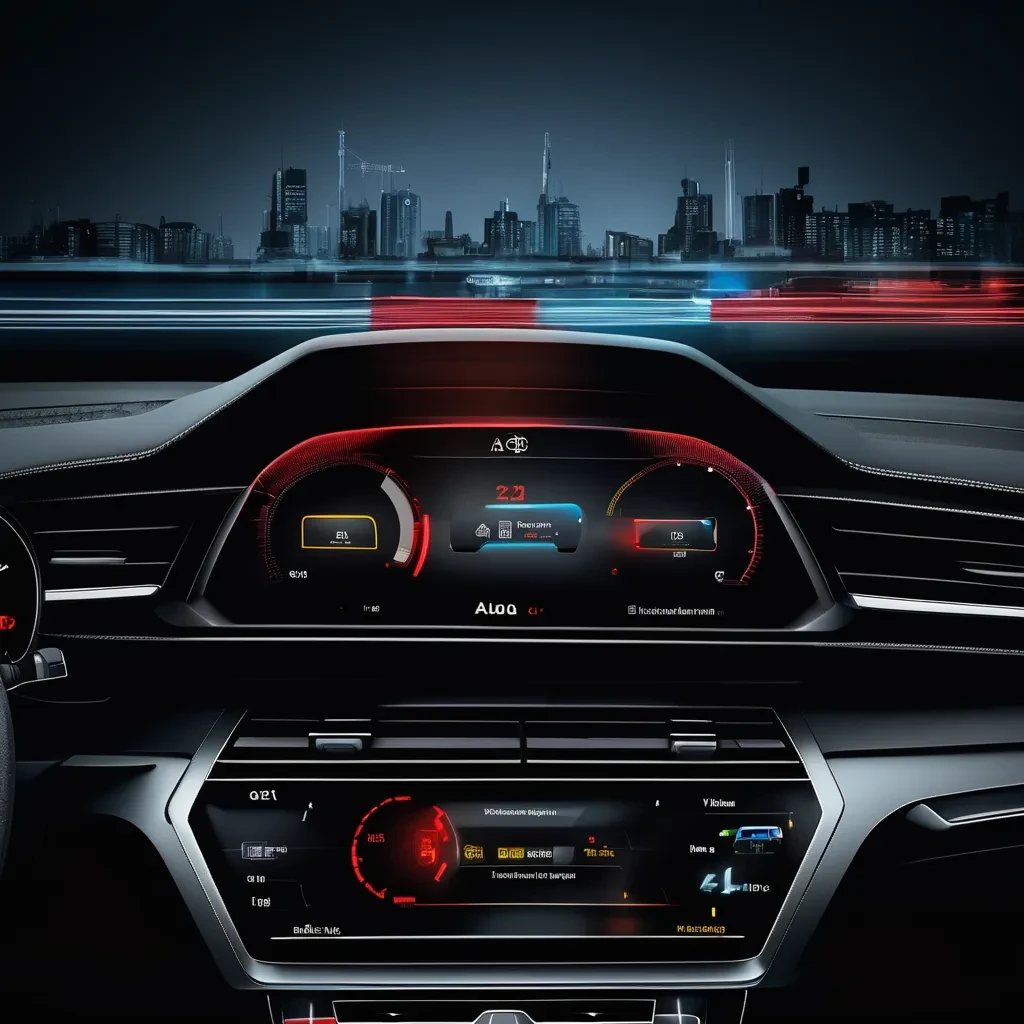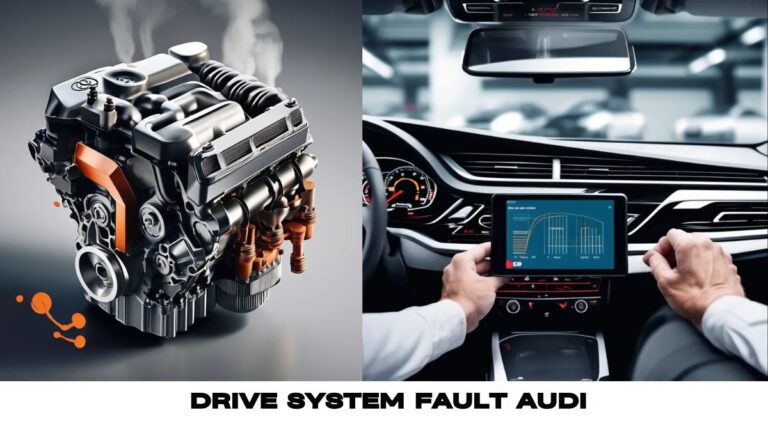When an Audi vehicle displays a “Drive System Fault” message, it can be a source of significant concern for drivers. This warning indicates that the vehicle’s drive system, which includes crucial components such as the transmission and differential, is experiencing a malfunction.
A drive system failure alert on the heads-up display means there’s an engine issue that needs attention. This is often due to an engine misfire, but other problems can also trigger the warning.
Understanding and addressing this issue promptly is essential to maintaining vehicle performance and safety. In this detailed guide, we will explore the common causes, symptoms, and solutions for a drive system fault in Audi vehicles.
Begin your journey to learn more about Audi with us.
Table of Contents:
Drive System Fault Audi – Brief Overview!
The “Audi Drive System Fault” message indicates a possible issue in the vehicle’s drive system, often due to an engine misfire. This may result in the engine shaking or vibrating. Sensors in the drive system monitor various components, and when they detect problems, they trigger this warning.

While engine misfire is a common cause, other factors like transmission or sensor issues could also be responsible. A thorough diagnostic check by a certified technician is needed to identify and fix the problem.
Typical Causes of Audi Drive System Problems – Detailed Instructions!
Engine Misfire:
Engine misfires, where cylinders fail to work properly, can cause mechanical instability, leading to noticeable engine vibrations or shaking.
Transmission Problems:
Issues within the transmission, such as faulty gears or components, can disrupt the drive system’s smooth operation. Timely diagnosis and repairs are crucial.

Sensor Malfunctions:
The drive system depends on sensors to monitor components. Malfunctioning sensors can trigger the “Drive System Fault” warning, indicating the need for investigation.
Read Also: Do Audi Dealers Negotiate? – A Complete Visual Guide!
Electrical System Issues:
Electrical system failures, including wiring or component problems, can affect communication within the drive system. Promptly addressing electrical issues ensures proper system function.
Faulty Software or Control Modules:
Software glitches or control module malfunctions can impact drive system performance, causing error messages or abnormal behavior. Thorough diagnostics and corrections are necessary.
Fluid Leaks or Contamination:
Transmission or fluid system leaks can reduce drive system efficiency. Contaminated fluids risk damaging components. Regular checks and fixing fluid issues are essential for performance.
Mechanical Wear and Tear:
Over time, drive system components wear down. Regular maintenance is critical to identify and fix issues early, preventing extensive damage and extending system life.
Understanding Common Causes
- Transmission Issues: Low fluid, worn clutch components, or control module failures can trigger drive system faults.
- Faulty Sensors: Malfunctioning sensors can send incorrect signals, causing warning messages.
- Electrical Problems: Faulty wiring or a failing alternator can also lead to drive system fault alerts.
- Software Glitches: Complex software systems in modern Audis can sometimes trigger false warnings.
Routine maintenance and early diagnostics ensure that the Audi drive system performs optimally and remains reliable.
Read Also: Audi Q5 Years to Avoid – Don’t take risks!
Warning Signs to Watch For in Your Audi’s Drive System
- Warning Lights: The “Drive System Fault” or other warnings indicate potential issues that need attention.
- Vibrations or Shaking: Unusual engine vibrations or shaking are often linked to engine misfires or transmission problems.
- Slipping Gears: Difficulty maintaining proper gear engagement suggests potential transmission issues.
- Unusual Noises: Strange sounds during acceleration or deceleration may indicate problems in the drive system components.
- Delayed Response: Delayed or unresponsive acceleration points to issues with the throttle or transmission.
- Fluid Leaks: Visible leaks beneath the vehicle signal potential problems with the fluid systems.
- Abnormal Smells: Burning odors from the engine or transmission could signify overheating or fluid issues.
- Difficulty Steering: Resistance or difficulty in steering may indicate problems with power steering components.
- Inconsistent Performance: Fluctuations in overall vehicle performance signal potential drive system irregularities.
- Electronic Display Messages: Warning messages on the instrument cluster indicate drive system issues that require attention.

Recognizing these signs and seeking professional diagnosis and repairs promptly can prevent further damage and ensure your Audi’s drive system continues to perform optimally.
Read Also: Audi vin decoder options list – Comprehensive Visual Guide!
Diagnosing Audi Drive System Malfunction – A Detailed Guide!
Diagnosing issues in an Audi drive system involves several key steps to ensure a thorough examination and effective resolution of potential problems.
1. Analyzing Diagnostic Trouble Codes:
Begin by performing a comprehensive scan of the vehicle’s system for trouble codes. These codes provide valuable information on specific areas that need further investigation.
2. Examination of Sensors and Wiring:
Inspect the sensors and wiring components of the drive system meticulously. This helps identify any anomalies or malfunctions in these critical elements.
3. Evaluation of Fuel Delivery System:
Check the fuel delivery system to ensure it is supplying fuel to the engine properly. Examine components for any issues that might affect performance.
4. Examination of the Ignition System:
Inspect the ignition system thoroughly to detect any potential malfunctions. This includes checking ignition components to ensure proper firing and combustion in the engine.
5. Scrutiny of Transmission and Exhaust System:
Perform a thorough inspection of the transmission and exhaust system components. Identify any faults or irregularities that could contribute to drive system malfunctions, ensuring a comprehensive diagnostic approach.

Read Also: Drive System Malfunction Audi Q7 – Let’s Explore!
Resolving Audi Drive System Faults – Here’s How!
If your Audi experiences a drive system fault due to spark plug issues, don’t worry. Restarting is often enough to solve the issue. If the issue persists, a quick visit to a car shop for a spark plug replacement will have you back on the road in no time.
Due to the complexity of drive system repairs, it’s best to seek professional help. For reliable and hassle-free service, visit Das European Autohaus near Spring and Houston, TX, and get your drive system restored quickly!

Understanding Audi Q7 Drive System Failure in Spring
If your mechanic tells you that your Audi Q7 has a drive system failure, it’s understandably concerning. Drive system failures are serious, but understanding them can help you manage the situation and reduce the risk of it happening to you.
What is Drive System Failure?
A drive system failure is a notification on the heads-up display indicating an engine issue. An engine misfire usually causes it but can result from other factors. An engine misfire occurs when one or more cylinders malfunction, causing the engine to shake. This instability is detected by the car’s sensors, triggering the drive system failure message.
Read Also: Drive System Malfunction Audi – Everything you need to know!
What To Try First?
When you see the drive system failure message, pull over and stop the car to avoid danger. Occasionally, a timing chain issue or a rough road can lead to engine misfires. Restarting the car might reset the electronics and clear the error message. If the message persists, it indicates a more serious, ongoing issue that needs addressing.
Fixing Engine Misfires:
Engine misfires can result from several issues, such as a faulty timing chain, a broken spark plug, or a leak. The engine needs adequate fuel, sufficient oxygen, and a spark to ignite the mixture. Problems with fuel or oxygen supply are often due to leaks or clogged valves, which require system replacement.

Faulty timing chains disrupt the synchronization of engine valves, leading to wasted fuel and reduced acceleration. In severe cases, the car can stall. Timing chains are usually replaced rather than repaired due to the difficulty of fixing them.
Read Also: Audi A4 Rattle When Accelerating – Causes, Diagnosis, and Solutions!
The Solution:
Drive system failure is not something to fear. Often, a quick shutdown and restart can resolve the issue. If not, a visit to a car shop for repairs or replacements is a straightforward solution.
Given the complexity of drive system repairs, seeking professional assistance is recommended. For fast and stress-free service, visit Das European Autohaus near Spring and Houston, TX, to get your drive system back in perfect condition.
What is the typical issue with Audis?
Audi owners often report several recurring issues, including:
- Electrical Problems: Faulty sensors and issues with the MMI (Multi-Media Interface) system are common.
- Oil Leaks: Leaks often stem from gasket or seal failures.
- Coolant Leaks: These usually occur due to worn hoses or radiator problems.
- Suspension Issues: Problems with suspension components can affect the vehicle’s handling and ride quality.
Read Also: Audi q7 years to avoid – Don’t take risks!
What is the Audi drive system’s malfunctioning battery?
A low battery voltage can activate the Audi Drive System Malfunction alert. Often, the battery itself is fine, but the charging system isn’t supplying enough power to charge it. This can happen if the vehicle isn’t driven regularly, causing the vehicle’s computer to continuously drain power from the battery.
What does a drivetrain malfunction mean?
It occurs when the car’s engine computer detects a problem in the engine or transmission. When this happens, your car may display the error message “Drivetrain Malfunction” and warn you to drive moderately.
Read Also: Audi Bluetooth Function is Currently Unavailable – Discuss with us!
What is meant by “drive system”?
A drive system converts electrical energy into mechanical (kinetic) energy using electric machines. These systems are crucial in automation, where many movements rely on electric drives.
Electronics are essential for controlling the drives and supplying them with electrical energy. Drive systems are used in various applications, from industrial machinery to electric vehicles, and play a vital role in improving efficiency and precision in automated processes.
What mileage do Audis start having problems?
The mileage can vary depending on the age and model of your Audi, but it’s typically around the 60,000-mile mark. Is this when you should consider having your Audi serviced and repaired more regularly? Yes, common issues with Audis at this point often involve the electrical system, engine, or suspension.
What is the Audi pre-sense system fault?
The Audi Pre Sense system relies on a complex network of electrical components to operate reliably. Faults in this system can arise from various electrical issues, such as blown fuses, damaged connectors, or poor wiring.
Read Also: Audi q8 throttle lag fix – Don’t take a risk!
What does the Audi engine malfunction indicator mean?
This light can indicate a range of problems, from minor issues like a broken electrical sensor to more significant mechanical issues, such as a fault in the emission control system or catalytic converter.
What does DTC stand for in an Audi?
DTC stands for Diagnostic Trouble Code. It is a code used by the vehicle’s onboard diagnostics (OBD) system to alert you to a specific problem with some aspect of the vehicle.
How can you find your Audi’s fault code?
Your Audi stores error codes in its fault memory and indicates their presence via the check engine light or a message on the information display. To read these codes, you can use an OBD diagnostic device, such as an Audi code reader, which allows you to access the control units and fault memory to view the stored errors.
This process helps identify and address specific issues within the vehicle’s systems.
Read Also: Does Valvoline do Audi oil Changes? – A Deep Dive!
Drive system fault Audi A3
A drive system fault in an Audi A3 indicates issues with the drivetrain, including the engine and transmission. Common causes are low battery voltage, transmission problems, engine issues, or electrical faults.
Symptoms include a dashboard warning light, reduced performance, and possible limp mode. To diagnose, use an OBD-II scanner or consult a mechanic. Regular maintenance and timely repairs can help prevent these faults. Regular driving and fluid checks are also essential.
Frequently Asked Questions:
Can regular maintenance prevent drive system faults in an Audi?
Yes, regular maintenance such as timely oil changes, fluid checks, and battery inspections can help prevent drive system faults and keep your Audi running smoothly.
What should I do if my Audi shows a drive system fault warning?
If your Audi displays a drive system fault warning, it is advisable to drive cautiously and seek immediate diagnostic assistance from a professional mechanic to prevent further damage.
How does low battery voltage cause a drive system fault in an Audi?
Low battery voltage can cause the vehicle’s computer systems to malfunction, leading to a drive system fault warning. Regular driving and battery checks can help maintain proper voltage levels.
Why does my Audi enter limp mode when there’s a drive system fault?
Limp mode is a safety feature that limits the vehicle’s speed and power to prevent further damage to the drivetrain when a fault is detected.
How often should I check the drivetrain components in my Audi?
It’s recommended to check drivetrain components during regular service intervals, typically every 10,000 to 15,000 miles, or as advised by your Audi’s maintenance schedule.
Can a drive system fault be caused by software issues?
Yes, sometimes drive system faults can be related to software issues or glitches within the vehicle’s computer systems, which may require a software update or recalibration.
What are the immediate steps to take if a drive system fault occurs while driving?
If a drive system fault occurs while driving, pull over safely, turn off the engine, and restart it. If the warning persists, consult a mechanic as soon as possible.
How does the Audi drive system fault impact the vehicle’s performance?
A drive system fault can lead to reduced power, difficulty shifting gears, and decreased fuel efficiency, affecting overall vehicle performance and drivability.
Are there any preventative measures to avoid drive system faults in an Audi?
Regular maintenance, prompt repairs of minor issues, and following the manufacturer’s service recommendations can help prevent drive system faults.
Conclusion:
Understanding and addressing drive system faults in Audi vehicles is crucial for maintaining performance and safety. Regular maintenance and prompt professional diagnosis can help manage and prevent these issues effectively.











